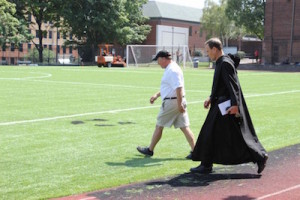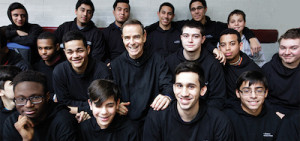THE RULE film “rules” major “60 Minutes” Segment
 Yes, it feels as if I “was led” to the “60 Minutes” segment on THE RULE film, coming home to write about a huge food event and not having seen the show for awhile. But there it was, sparking renewed excitement.
Yes, it feels as if I “was led” to the “60 Minutes” segment on THE RULE film, coming home to write about a huge food event and not having seen the show for awhile. But there it was, sparking renewed excitement.
It’s been almost two years since I watched and rematched THE RULE – as much because it was so inspired it had distinct voice of its own and because it captured the essence of what we at the National Teacher Corps had as our mission years ago. I know. I was the editor of their newspaper and knew of most of the national projects. Here is my review.
Like it’s title, the THE RULE documentary film, is deceptively simple. Referring to the concise, enduring little document of the same name that St. Benedict wrote in 530 AD to pattern monastic life, it is as spiritual and rich as it is practical. THE RULE film profiles the monks at St. Benedict Prep (SBP) and how they use the original concepts as a guideline for stunning success in their inner city Newark school with at-risk students. THE RULE is a must-see — inspiring, witty and engaging.

THE RULE – inspiring, witty, engaging
This feature is the second in the acclaimed 3Rs Trilogy of documentaries on Urban America by Emmy-nominated, award winning, husband and wife, Newark filmmakers Marylou & Jerome Bongiorno. This time four years of filming become an engaging 90-minute feature, with each rule exemplified by a concept at the school.
 Testimony to the power St. Benedict Prep (SBP), located in the heart of Newark, where the average high school graduation rate is abysmal, is that it boasts a near 100 percent college acceptance rate for their predominantly African American and Latino young at risk student graduates, and almost equally high college graduation rate. Many of the graduates become working professionals, with several joining the SBP staff, and almost all are members of the strong SBP alumni network.
Testimony to the power St. Benedict Prep (SBP), located in the heart of Newark, where the average high school graduation rate is abysmal, is that it boasts a near 100 percent college acceptance rate for their predominantly African American and Latino young at risk student graduates, and almost equally high college graduation rate. Many of the graduates become working professionals, with several joining the SBP staff, and almost all are members of the strong SBP alumni network.
This achievement on a continual basis is stunning in light of Newark’s lower socioeconomic environment. In the words of one monk, “hard work and education equals success everywhere but here. We strive to provide a connection between hard work and success.” Yet the monks themselves say: Other generations of poverty understood the work ethic because they experienced it. We need jobs, not more job training; the kids need to experience for the first time that work = success.
The Benedictine monks of Newark Abbey are engaging, almost charismatic. That they lifted cloister for Marylou to come in and film with Jerome is representative of their genuinely open, progressive, intelligent nature. Wry and witty, they make it seem effortless to provide the shelter of a home for some 65 kids, some from semi-functional families, and they watch over them 11 months a year.
“You gotta live in the area,” is a recurrent theme inside the monastery and from the filmmakers who live in Newark. Father Edwin: “The African-American community comes from a different place, a subculture in this inner city. Both the African-American and the Latinos we work with have suffered horrors we haven’t but we have to address.
According to Father Albert, “The monastery is in dialogue with surroundings. We are in the midst of the sounds around us in the inner city. They make us aware.” One of the most moving scenes shows Brother Max meditating in the worn yard with the sounds of the city around him.
THE RULE is the perfect groundwork, originally such a strong tool that Benedictine monasteries spread through Italy and then Europe in the midst of political upheaval. In the Rule’s prologue, Benedict wrote he intended to prescribe “nothing harsh, nothing burdensome” for his followers. His approach to seeking God was both sensible and humane.
This becomes the SBP philosophy. Toward this end, the monks are highly respective to the students and gear education toward the students’ need, and “constantly reinvent ourselves.” To watch the monks almost off-handedly, elegantly, teach experiential education (writing blogs, five-day hikes in the film!) is for a filmgoer entertaining; to watch it as an educator is revelatory.

Headmaster Fr. Edwin Leahy and students at SBP, Newark
The RULE of learning and practicing “Community” is crucial and students must participate. Leadership skills are learned from student governing, for example. Said one monk: “If you’re old enough and you’re capable enough you can run the school’ and there has been a group system since 1976 with student leaders for each 120 kids. Leadership training is also incorporated into five-day, student-led hikes and in sports (champion teams, of course).
 In the Rule of 3, students can be sent away for infractions of communal life, such as carrying a weapon. “Some students leave and come back; those who leave for good usually go to another school,” reported Marylou.
In the Rule of 3, students can be sent away for infractions of communal life, such as carrying a weapon. “Some students leave and come back; those who leave for good usually go to another school,” reported Marylou.
Spirituality rather than religion is a major component in THE RULE. “We fall down and we get up, we fall down and we get up,” one monk tells us. “The most powerful human experience is to feel forgiveness. If you can’t forgive someone it will take your heart and tear in in two. You love someone in spite of their faults not because of their virtues.”

The counterpart to work, prayer five times a day
In 1973 a new abbot transformed Newark Abbey into a classic monastery following the original RULES guidelines of equal work and prayer (five times a day) for balance. The monks are grateful. “The school could easily take up all our time and energy,” said one. “Prayer also provides solace when we hear of students being killed in the Newark streets, or a student goes astray.”
Prayer also requires a discipline that permeates St. Benedict’s. “That’s what we’re supposed to be good at… as monks, monks are supposed to be seeking God…, And that takes a discipline.. and if you just stand still and be quiet, the lord will eventually catch up to with you… ,” a monk ruminates. And boy, if that’s something you could teach the kids, then I don’t care what his board scores are.”
Marylou explained that, “Making this film we learned that, for inner city youth, cognitive skills are impeded by the dysfunctional environment caused by poverty. At SBP, this commitment includes protracted counseling as well as a year-round residence for the most vulnerable students. We’ve been to other monasteries and realized that SBP was different because this is really down and dirty – where the action is.”
She filled in how this superb film came to be made. “The rule of thumb is: “write what you know.” When asked if they were social activists, Jerome chuckled, “Let’s just say we keep turning over rocks and looking under them.”
The Bongiornos’ award-winning documentary, “Revolution ’67,” premiered nationally on the PBS series “P.O.V.” It explored the urban rebellion that exploded in Newark in July 1967, and the root problems that sparked it and in cities across the country. “We’ve been citing the recommendations for cities that were not followed when the Kerner commission weighed in on revolution ’67,” explained Jerome.
Recently I reconnected with social activist, attorney Ira T. Simmons, a head investigator on the Kerner Commission, who quietly noted that “we wrote an important document, now collecting dust. I don’t think we (in America) have learned anything from it yet.” The Bongiornos’ films now show differently.
Flick Conot, wife of the Kerner Commission Report head writer, Robert Conot (who, in fact, did much of the Newark investigation), said, “Bob would have been so pleased with these films. They depict a community-spiritual model for healing. It’s a wonderful way to get people galvanized and start change.”
And for me, who worked on Bob Conot’s staff, and was previously in the National Teacher Corps in Washington, D.C. (where I created a citywide field trip program that continues to this day in order to provide a sense of community for my at-risk students), the film provided so much personal inspiration and insight. Even without the attempt to write a college curriculum for future educators from THE RULES, the film alone will be a transformational teaching tool for any teacher.
Film’s website: www.TheRuleFilm.com. The exclusive Los Angeles County engagement begins Friday, September 12th at the Town Center 5, 17200 Ventura Blvd., Encino CA 91316, (310) 478-3836. www.laemmle.com.

Monks and filmmaker/director Marylou Bongiorno during the production of THE RULE

Marylou and Jerome Bongiorno

